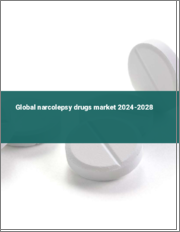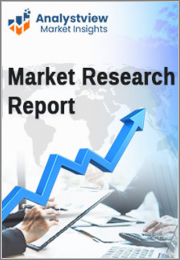
|
시장보고서
상품코드
1722507
기면증 치료제 시장 보고서 : 유형별, 질환 유형별, 치료 유형별, 지역별(2025-2033년)Narcolepsy Drugs Market Report by Type, Disease Type, Therapeutic Type, and Region 2025-2033 |
||||||
세계 기면증 치료제 시장 규모는 2024년 35억 달러에 달했습니다. 향후 IMARC Group은 2033년까지 65억 달러에 달하고, 2025-2033년 연평균 성장률(CAGR)은 6.64%를 보일 것으로 전망하고 있습니다. 기면증에 대한 인식과 진단 증가, 수면장애의 신흥국 시장 확대, 진행 중인 의약품 개발의 발전, 양호한 규제 환경이 시장 성장을 가속하고 있습니다.
기면증 치료제는 만성 수면장애의 치료에 사용되는 의약품을 말합니다. 이 질환은 주간 과도한 졸음(EDS), 기면증 또는 갑작스러운 근력저하, 수면마비, 환각, 단편적인 수면, 불면증 등이 특징입니다. 기타 증상으로는 의식과 무관한 자동적 행동, 눈의 흐릿함, 복시, 안검하수, 정신 기능의 장애 등이 있습니다. 기면증 환자는 하루 수면시간은 정상인과 동일하지만 수면의 질이 떨어지는 경향이 있습니다. 일반적으로 사용되는 기면증 약물에는 중추신경 자극제, 옥시베이트 나트륨, 선택적 세로토닌 재흡수 억제제, 삼환계 항우울제 등이 있습니다. 이들 약물은 성인 환자의 각성을 개선하고 환각, 졸음, 기면증을 최소화합니다.
기면증 치료제 시장 동향 :
세계적으로 기면증의 유병률이 증가하고 있는 것은 시장 성장을 가속하는 주요 요인 중 하나입니다. 이는 노동 인구의 좌식 생활 방식과 바쁜 일정으로 인해 수면 관련 장애의 발생 건수가 크게 증가했기 때문입니다. 또한, 대중의 건강 인식이 높아지고 사용 가능한 치료법에 대한 인식이 높아짐에 따라 시장 성장을 가속하고 있습니다. 이와 함께, 소아 기면증 치료에 나트륨 옥시베이트가 널리 채택되고 있는 것도 시장 성장에 기여하고 있습니다. 또한, 기면증 진단 기술이 크게 개선된 것도 성장을 가속하는 요인으로 작용하고 있습니다. 제약업체들은 장기적인 효과와 부작용을 줄인 변종을 개발하고 있습니다. 이러한 질병에 취약한 노인 인구 증가와 신경학 분야의 광범위한 조사 개발(R&D) 활동과 같은 다른 요인들도 시장 성장을 가속할 것으로 예측됩니다.
본 보고서에서 다룬 주요 질문
- 기면증 치료제 시장 규모는?
- 기면증 치료제 시장 전망은?
- 기면증 치료제 시장을 이끄는 주요 요인은?
- 기면증 치료제 시장에서 가장 큰 점유율을 차지하는 지역은?
- 세계 기면증 치료제 시장의 주요 기업은?
목차
제1장 서문
제2장 조사 범위와 조사 방법
- 조사 목적
- 이해관계자
- 데이터 소스
- 1차 정보
- 2차 정보
- 시장 추정
- 보텀업 접근
- 톱다운 접근
- 조사 방법
제3장 주요 요약
제4장 서론
- 개요
- 주요 업계 동향
제5장 세계의 기면증 치료제 시장
- 시장 개요
- 시장 실적
- COVID-19의 영향
- 시장 예측
제6장 시장 분석 : 유형별
- 탈진 발작을 수반하는 기면증
- 탈진 발작을 수반하지 않는 기면증
- 2차성 기면증
제7장 시장 분석 : 질환 유형별
- 주간의 극심한 졸음
- 탈진 발작
- 기타
제8장 시장 분석 : 치료 유형별
- 옥시산나트륨
- 중추 신경 자극제
- 삼환계 항우울제
- 선택적 세로토닌 재흡수 억제제
- 기타
제9장 시장 분석 : 지역별
- 북미
- 미국
- 캐나다
- 아시아태평양
- 중국
- 일본
- 인도
- 한국
- 호주
- 인도네시아
- 기타
- 유럽
- 독일
- 프랑스
- 영국
- 이탈리아
- 스페인
- 러시아
- 기타
- 라틴아메리카
- 브라질
- 멕시코
- 기타
- 중동 및 아프리카
- 시장 내역 : 국가별
제10장 SWOT 분석
- 개요
- 강점
- 약점
- 기회
- 위협
제11장 밸류체인 분석
제12장 Porter의 Five Forces 분석
- 개요
- 바이어의 교섭력
- 공급 기업의 교섭력
- 경쟁 정도
- 신규 진출업체의 위협
- 대체품의 위협
제13장 가격 분석
제14장 경쟁 구도
- 시장 구조
- 주요 기업
- 주요 기업 개요
- Avadel Pharmaceuticals plc
- Axsome Therapeutics Inc.
- Bioprojet Pharma
- Graymark Healthcare Inc.
- Jazz Pharmaceuticals plc
- Ligand Pharmaceuticals Incorporated
- Novartis AG
- SHIONOGI & Co. Ltd.
- Takeda Pharmaceutical Company Limited
- Teva Pharmaceutical Industries Ltd.
The global narcolepsy drugs market size reached USD 3.5 Billion in 2024. Looking forward, IMARC Group expects the market to reach USD 6.5 Billion by 2033, exhibiting a growth rate (CAGR) of 6.64% during 2025-2033. The increasing awareness and diagnosis of narcolepsy, growing prevalence of sleep disorders, ongoing advancements in drug development, and favorable regulatory environment are primarily driving the market's growth.
Narcolepsy drugs refer to pharmaceutical medicines used for the treatment of chronic sleep disorders. The disorder is characterized by excessive daytime sleepiness (EDS), cataplexy or sudden loss of muscle strength, sleep paralysis, hallucinations, fragmented sleep and insomnia. Additional symptoms may include automatic behaviors without conscious awareness, blurred vision, double vision or droopy eyelids and disturbed mental functioning. Patients suffering from narcolepsy tend to sleep the same number of hours per day as normal individuals; however, sleep quality tends to be poorer. Some of the commonly used narcolepsy drugs include central nervous system stimulants, sodium oxybate, selective serotonin reuptake inhibitors and tricyclic antidepressants. These drugs aid in improving wakefulness in adult patients and minimizing hallucinations, sleepiness and cataplexy.
Narcolepsy Drugs Market Trends:
The increasing prevalence of narcolepsy across the globe is one of the key factors driving the growth of the market. This can be attributed to the sedentary lifestyles and hectic schedules of the working population, which, in turn, is significantly increasing the incidences of sleep-related disorders. Moreover, rising health consciousness among the masses and the increasing awareness regarding the available treatment alternatives are providing a thrust to the market growth. In line with this, the widespread adoption of sodium oxybate for the treatment of narcolepsy in children is also contributing to the growth of the market. Additionally, significant improvements in the diagnostic technologies for narcolepsy are acting as other growth-inducing factors. Pharmaceutical manufacturers are also developing variants with long-term benefits and reduced side effects. Other factors, including the rising geriatric population, which is more susceptible to such ailments, along with extensive research and development (R&D) activities in the field of neurology, are anticipated to drive the market toward growth.
Key Market Segmentation:
Breakup by Type:
- Narcolepsy with Cataplexy
- Narcolepsy without Cataplexy
- Secondary Narcolepsy
Breakup by Disease Type:
- Daytime Extreme Sleepiness
- Cataplexia
- Others
Breakup by Therapeutic Type:
- Sodium Oxybate
- Central Nervous System Stimulants
- Tricyclic Antidepressants
- Selective Serotonin Reuptake Inhibitor
- Others
Breakup by Region:
- North America
- United States
- Canada
- Asia-Pacific
- China
- Japan
- India
- South Korea
- Australia
- Indonesia
- Others
- Europe
- Germany
- France
- United Kingdom
- Italy
- Spain
- Russia
- Others
- Latin America
- Brazil
- Mexico
- Others
- Middle East and Africa
Competitive Landscape:
The competitive landscape of the industry has also been examined along with the profiles of the key players being Avadel Pharmaceuticals plc, Axsome Therapeutics Inc., Bioprojet Pharma, Graymark Healthcare Inc., Jazz Pharmaceuticals plc, Ligand Pharmaceuticals Incorporated, Novartis AG, SHIONOGI & Co. Ltd., Takeda Pharmaceutical Company Limited and Teva Pharmaceutical Industries Ltd.
Key Questions Answered in This Report
- 1.How big is the narcolepsy drugs market?
- 2.What is the future outlook of narcolepsy drugs market?
- 3.What are the key factors driving the narcolepsy drugs market?
- 4.Which region accounts for the largest narcolepsy drugs market share?
- 5.Which are the leading companies in the global narcolepsy drugs market?
Table of Contents
1 Preface
2 Scope and Methodology
- 2.1 Objectives of the Study
- 2.2 Stakeholders
- 2.3 Data Sources
- 2.3.1 Primary Sources
- 2.3.2 Secondary Sources
- 2.4 Market Estimation
- 2.4.1 Bottom-Up Approach
- 2.4.2 Top-Down Approach
- 2.5 Forecasting Methodology
3 Executive Summary
4 Introduction
- 4.1 Overview
- 4.2 Key Industry Trends
5 Global Narcolepsy Drugs Market
- 5.1 Market Overview
- 5.2 Market Performance
- 5.3 Impact of COVID-19
- 5.4 Market Forecast
6 Market Breakup by Type
- 6.1 Narcolepsy with Cataplexy
- 6.1.1 Market Trends
- 6.1.2 Market Forecast
- 6.2 Narcolepsy without Cataplexy
- 6.2.1 Market Trends
- 6.2.2 Market Forecast
- 6.3 Secondary Narcolepsy
- 6.3.1 Market Trends
- 6.3.2 Market Forecast
7 Market Breakup by Disease Type
- 7.1 Daytime Extreme Sleepiness
- 7.1.1 Market Trends
- 7.1.2 Market Forecast
- 7.2 Cataplexia
- 7.2.1 Market Trends
- 7.2.2 Market Forecast
- 7.3 Others
- 7.3.1 Market Trends
- 7.3.2 Market Forecast
8 Market Breakup by Therapeutic Type
- 8.1 Sodium Oxybate
- 8.1.1 Market Trends
- 8.1.2 Market Forecast
- 8.2 Central Nervous System Stimulants
- 8.2.1 Market Trends
- 8.2.2 Market Forecast
- 8.3 Tricyclic Antidepressants
- 8.3.1 Market Trends
- 8.3.2 Market Forecast
- 8.4 Selective Serotonin Reuptake Inhibitor
- 8.4.1 Market Trends
- 8.4.2 Market Forecast
- 8.5 Others
- 8.5.1 Market Trends
- 8.5.2 Market Forecast
9 Market Breakup by Region
- 9.1 North America
- 9.1.1 United States
- 9.1.1.1 Market Trends
- 9.1.1.2 Market Forecast
- 9.1.2 Canada
- 9.1.2.1 Market Trends
- 9.1.2.2 Market Forecast
- 9.1.1 United States
- 9.2 Asia-Pacific
- 9.2.1 China
- 9.2.1.1 Market Trends
- 9.2.1.2 Market Forecast
- 9.2.2 Japan
- 9.2.2.1 Market Trends
- 9.2.2.2 Market Forecast
- 9.2.3 India
- 9.2.3.1 Market Trends
- 9.2.3.2 Market Forecast
- 9.2.4 South Korea
- 9.2.4.1 Market Trends
- 9.2.4.2 Market Forecast
- 9.2.5 Australia
- 9.2.5.1 Market Trends
- 9.2.5.2 Market Forecast
- 9.2.6 Indonesia
- 9.2.6.1 Market Trends
- 9.2.6.2 Market Forecast
- 9.2.7 Others
- 9.2.7.1 Market Trends
- 9.2.7.2 Market Forecast
- 9.2.1 China
- 9.3 Europe
- 9.3.1 Germany
- 9.3.1.1 Market Trends
- 9.3.1.2 Market Forecast
- 9.3.2 France
- 9.3.2.1 Market Trends
- 9.3.2.2 Market Forecast
- 9.3.3 United Kingdom
- 9.3.3.1 Market Trends
- 9.3.3.2 Market Forecast
- 9.3.4 Italy
- 9.3.4.1 Market Trends
- 9.3.4.2 Market Forecast
- 9.3.5 Spain
- 9.3.5.1 Market Trends
- 9.3.5.2 Market Forecast
- 9.3.6 Russia
- 9.3.6.1 Market Trends
- 9.3.6.2 Market Forecast
- 9.3.7 Others
- 9.3.7.1 Market Trends
- 9.3.7.2 Market Forecast
- 9.3.1 Germany
- 9.4 Latin America
- 9.4.1 Brazil
- 9.4.1.1 Market Trends
- 9.4.1.2 Market Forecast
- 9.4.2 Mexico
- 9.4.2.1 Market Trends
- 9.4.2.2 Market Forecast
- 9.4.3 Others
- 9.4.3.1 Market Trends
- 9.4.3.2 Market Forecast
- 9.4.1 Brazil
- 9.5 Middle East and Africa
- 9.5.1 Market Trends
- 9.5.2 Market Breakup by Country
- 9.5.3 Market Forecast
10 SWOT Analysis
- 10.1 Overview
- 10.2 Strengths
- 10.3 Weaknesses
- 10.4 Opportunities
- 10.5 Threats
11 Value Chain Analysis
12 Porters Five Forces Analysis
- 12.1 Overview
- 12.2 Bargaining Power of Buyers
- 12.3 Bargaining Power of Suppliers
- 12.4 Degree of Competition
- 12.5 Threat of New Entrants
- 12.6 Threat of Substitutes
13 Price Analysis
14 Competitive Landscape
- 14.1 Market Structure
- 14.2 Key Players
- 14.3 Profiles of Key Players
- 14.3.1 Avadel Pharmaceuticals plc
- 14.3.1.1 Company Overview
- 14.3.1.2 Product Portfolio
- 14.3.1.3 Financials
- 14.3.1.4 SWOT Analysis
- 14.3.2 Axsome Therapeutics Inc.
- 14.3.2.1 Company Overview
- 14.3.2.2 Product Portfolio
- 14.3.2.3 Financials
- 14.3.3 Bioprojet Pharma
- 14.3.3.1 Company Overview
- 14.3.3.2 Product Portfolio
- 14.3.4 Graymark Healthcare Inc.
- 14.3.4.1 Company Overview
- 14.3.4.2 Product Portfolio
- 14.3.5 Jazz Pharmaceuticals plc
- 14.3.5.1 Company Overview
- 14.3.5.2 Product Portfolio
- 14.3.5.3 Financials
- 14.3.5.4 SWOT Analysis
- 14.3.6 Ligand Pharmaceuticals Incorporated
- 14.3.6.1 Company Overview
- 14.3.6.2 Product Portfolio
- 14.3.6.3 Financials
- 14.3.6.4 SWOT Analysis
- 14.3.7 Novartis AG
- 14.3.7.1 Company Overview
- 14.3.7.2 Product Portfolio
- 14.3.7.3 Financials
- 14.3.7.4 SWOT Analysis
- 14.3.8 SHIONOGI & Co. Ltd.
- 14.3.8.1 Company Overview
- 14.3.8.2 Product Portfolio
- 14.3.8.3 Financials
- 14.3.8.4 SWOT Analysis
- 14.3.9 Takeda Pharmaceutical Company Limited
- 14.3.9.1 Company Overview
- 14.3.9.2 Product Portfolio
- 14.3.9.3 Financials
- 14.3.9.4 SWOT Analysis
- 14.3.10 Teva Pharmaceutical Industries Ltd.
- 14.3.10.1 Company Overview
- 14.3.10.2 Product Portfolio
- 14.3.10.3 Financials
- 14.3.10.4 SWOT Analysis
- 14.3.1 Avadel Pharmaceuticals plc



















